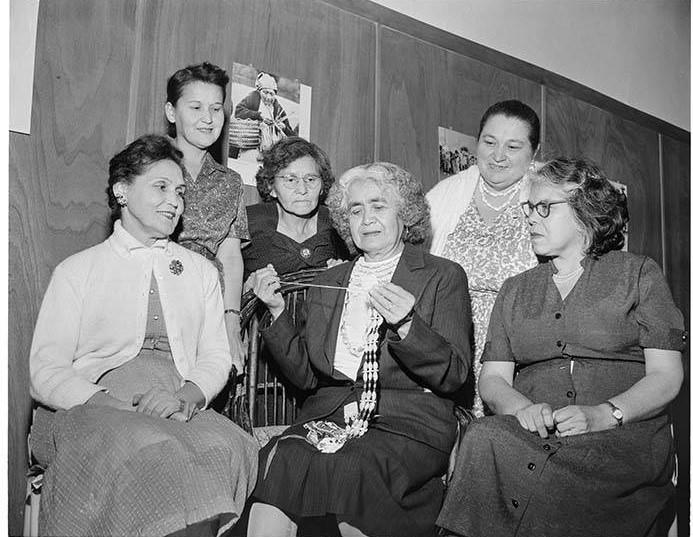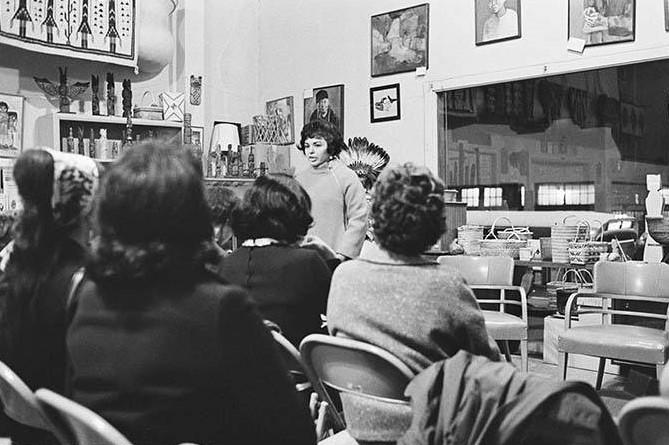The kind Native women who volunteered there were not outsiders or government workers. They were Native mothers and grandmothers who saw in the faces of the Native street people the eyes of their ancestors pleading for help.
Seven Native mothers, led by Pearl Warren from the Makah tribe, formed the first “urban Indian” support organization in the country, the American Indian Women’s Service League. The group formed political inroads that contributed to the Red Power Movement, and became a wellspring that gave birth to a number of important Native service organizations that continue their work today.
The birth of the American Indian Women’s Service League
“Indian people have radar,” says Jackie Swanson (Muckleshoot/Warm Springs), an early member of the Service League. It’s that power of observation that led to the formation of the League in the first place.
“The story is there was a Makah woman who was approached by a couple from Montana, and the husband had been released from the hospital,” Swanson says.
The federal government’s Indian Health Service (IHS), which has a trust obligation to provide health care to federally recognized tribes, had paid to send the couple to Seattle for a medical procedure to be performed on the husband. But once the procedure was completed and the husband was discharged, the IHS obligation was fulfilled. The agency made no arrangements for the couple to return to Montana.
Frightened, intimidated and no doubt feeling out of place among all the white faces, they had no one to turn to, until one smiling Native face appeared out of the crowd.
“With the Indian radar they noticed this Makah woman. They went to her and told her their plight: that they were stuck in Seattle, that he’d been released from the hospital with no way home,” says Swanson. That Makah woman was Mary Jo Butterfield, the daughter of Pearl Warren. Together with her mother and some friends, Butterfield helped the couple find the resources to return home. After the incident, the seven mothers realized there was a massive gap in social services for Native people in Seattle.
In 1956, Congress passed the Indian Relocation Act, which paid for Native people to move to large cities and promised them job training programs as an incentive. But the shock of moving to the big city was too much for many. Places like Seattle, San Francisco, Chicago and Minneapolis were huge, impersonal urban centers compared to the remote rural reservations they were used to, and many dropped out of the ineffective training programs that had lured them to the city. Once out of the programs, they were left to fend for themselves with absolutely no assistance from the government.
Many believe this had been the plan all along, to kill Indian people with despair and then assimilate the few who survived. After that, the government would have no more obligations to the Native people whose land they stole. In effect, the urban Indians of Seattle were abandoned and left to die miserable deaths on the street.
“The sooner we can get the Indians into the cities, the sooner the government can get out of the Indian business,” the head of the Indian Claims Commission, Republican Sen. Arthur Watkins, is quoted as saying in a 1969 Seattle Post-Intelligencer article.
So on September 10, 1958, the seven mothers formed the American Indian Women’s Service League to save those who had been left to struggle alone.
A welcoming atmosphere
It took two years to raise the money to open the first Seattle Indian Center. The group held rummage sales, potluck dinners and salmon bakes with donated salmon. They also solicited donations from individuals, church groups and tribes.
But the Native mothers’ real work was out on the street. Warren and the others would stake out the bus terminal and stop anyone who looked Indian, asking if they needed help. They searched the streets and were not afraid to knock on doors in rundown hotels and tenements looking for Native people in need.
“They were like the Welcome Wagon,” remembers Ramona Bennett (Puyallup), an early volunteer.
In 1968 the center helped solve the problems of 3,917 Native people, according to one news story. But more telling than that, in one seven-month period in 1961, they served 5,592 people coffee, according to an Indian Center News story, attesting to the Seattle Indian Center’s “living-room atmosphere.” Intertribal fellowship was one of the group’s earliest and most important principles.
The American Indian Women's Service League grew out of a 1958 meeting of American Indian women sharing their concerns over the living conditions their people faced. The organization became the Seattle Indian Center (SIA) in 1972, which to this day provides services and assistance to all people. Opening in Belltown at 2604 First Avenue, the SIA is now located at 1265 South Main Street. (MOHAI, Seattle Post-Intelligencer Photograph Collection, 1986.5.53361.1)
The most powerful medicine of all
The people who volunteered at the Center were often not much better off than those they were helping. Most volunteered because it gave them the satisfaction of helping and socializing with other Native people. Those who received assistance often became volunteers themselves.
One woman, according to Service League member Lillian Chappell, after receiving help getting clothes for her children, became the head of the clothing committee, finding wearable used clothing for people going on job interviews or for children preparing for a new school year.
And quite often, volunteers were the children of previous volunteers, emphasizing the powerful role of mothers in Indigenous societies and adding to the Center’s familial and tribal quality.
But this is not to say they didn’t work hard. One Indian Center report noted volunteers performed 1,140 hours of work during January and February 1961. One of the founding members, Ella Aquino, took over the responsibility of publishing and writing the Northwest Indian News, which became the Service League’s newsletter, and the Indian Center News — both of which became critical sources of Indigenous journalism for Seattle’s Native community. The publications helped inform, and more important unite, the Native people in Seattle from 1957 to 1980.
Aquino’s granddaughter Linda Soriano remembers how Aquino prepared the newsletter and took the bus every month to the post office to mail them to hundreds of subscribers. “She knew how important it was for the Native community to stay connected,” Soriano recalls.
With only an eighth-grade education and no experience as a journalist, Aquino learned how to run the mimeograph machine and do the layouts, and even wrote a column called “Teepee Talk.”
The deep satisfaction that came from helping fellow Native people became the most powerful medicine the Service League dispensed for healing a generation of wounded spirits.
“It changed my life”
Slowly, as the Service League grew, more emphasis was placed on preventing emergencies among Seattle’s urban Native population instead of simply dealing with them. To do this, the Service League needed more money than they could raise through bake sales and donations.
Ramona Bennett, who began volunteering at the Seattle Indian Center in 1964, remembers how Pearl Warren spotted her potential immediately.
“Pearl Warren taught me how to write basic grants to get dollars to provide services for the city Indian people,” Bennett recalls. Before then, Bennett had worked as a directory assistance operator for Pacific Northwest Bell and had organized a union walkout for higher wages and benefits. The Teamsters offered her a job as a union official, which would have resulted in a lucrative career. But once she got to know the other women of the Service League, she felt a real sense of belonging.
“I was more comfortable and much happier with my own people than I had ever been in that other world,” Bennett remembers. “The Service League completely changed my life.”
Later, another founding member of the Service League, Adeline Garcia, paid the tuition for Bennett to return to school to receive a master’s degree in social work.
“When I asked her how I can pay her back, she said, ‘Don’t pay back, come back.’” And Bennett did, working for five years as a social worker at the Seattle Indian Center after receiving her degree.
Bennett then got elected to the Puyallup tribal council and later served as the tribal chair from 1971 to 1978. The federal government considered the tribe terminated, but Bennett dug in and researched tribal history, creating an updated roll of members based on records that were nearly lost. She pulled her tribe back from the brink of termination — thanks, in part, to the leadership she witnessed and learned in the Service League.
The legacy of the American Indian Women’s Service League
Pearl Warren resigned from the Seattle Indian Center and the Service League in 1970, after serving 10 years as director. Warren’s style of leadership was based on love and a desire to help Native people. She understood the healing power of helping, both for those being helped and those doing the helping. This reflects the deeply embedded tradition of matrilineal power that moves almost invisibly in all Native cultures.
But by 1970, a new generation of administrators had taken over, who resented the near-total control Warren had over the Center and the Service League. They also wanted to take better advantage of the opportunities government grants offered them.
Warren had resisted basing the Service League’s budget on government grants, using them only as a last resort. Having come from a period when no government funds were available to help the plight of urban Native people, her philosophy had always been one of self-sufficiency and self-determination. The Service League’s motto was “Helping Indians Help Themselves.”
The new generation “weren’t even interested in being Indian before the Service League came along,” she famously said.
Once, no one cared about the urban Native people destined to die on the streets of Seattle. But Pearl Warren, Adeline Garcia, Ella Aquino, Mary Jo Butterfield, and the other founding members of the Service League built their organization into a formidable force for change.
The American Indian Women’s Service League continued, but after Warren left many people complained that the League and the Seattle Indian Center had devolved into standard social-service organizations and lost most of their tribal quality.
“Once money came into the picture, things changed, and it got a lot more political … that turned off a lot of people,” Marilyn Bentz, director of the Center for American Indian and Indigenous Studies at the University of Washington, says in the book Native Seattle: Histories of the Crossing-Over Place, by Coll Thrush.
The League eventually dissolved in the mid-’80s. But the Seattle Indian Center still exists, providing, among many other things, a food bank, a day center where Native people can socialize, education and employment assistance and community outreach services.
One could argue that this shift was necessary to attract the government funds to build a more efficient system for helping Seattle’s Native population. The Seattle Indian Health Board, the Thunderbird Treatment Center, and the Daybreak Star Indian Cultural Center, all of which help thousands of Native people each year, were started by former Service League volunteers with the help of millions of dollars in government funds. Adeline Garcia, for example, went on to become president of the Seattle Indian Health Board.
But one could also argue that none of the new generation of leadership, many of whom were bureaucrats or Native politicians, had the wherewithal to stake out bus stations or knock on tenement doors looking for Native people to help. It all started with Warren and the founding mothers of the American Indian Women’s Service League, carrying out their traditional roles as caretakers of the culture — a tradition that goes back thousands of years, and one that will never die. It was this tribal quality that saved urban Indians in Seattle from falling off the edge.




